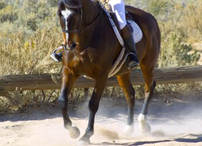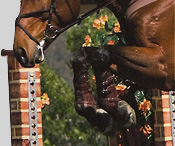



RECOGNIZING LAMINITIS (FOUNDER)

Learn to Recognize the Signs of Laminitis
Every day veterinarians across the country see hundreds of cases of laminitis, a painful disease that affects the feet of horses. Laminitis results from the disruption of blood flow to the sensitive and insensitive laminae within the foot, which secure the coffin bone to the hoof wall. While the exact mechanisms by which the feet are damaged remain a mystery, certain precipitating events can produce laminitis. Although laminitis occurs in the feet, the underlying cause is often a disturbance elsewhere in the horse’s body.
As a horse owner, it is important to recognize the signs of laminitis and seek veterinary help immediately. Signs of acute laminitis include the following:
- Lameness, especially when a horse is turning in circles; shifting lameness when standing
- Heat in the feet
- Increased digital pulse in the feet
- Pain in the toe region when pressure is applied with hoof testers
- Reluctant or hesitant gait, as if “walking on eggshells”
- A “sawhorse stance,” with the front feet stretched out in front to alleviate pressure on the toes and the hind feet “camped out” or positioned farther back than normal to bear more weight
- Signs of chronic laminitis may include the following:
- Rings in hoof wall that become wider as they are followed from toe to heel
- Bruised soles or “stone bruises”
- Widened white line, commonly called “seedy toe,” with occurrence of blood pockets
and/or abscesses - Dropped soles or flat feet
- Thick, “cresty” neck
- Dished hooves, which are the result of unequal rates of hoof growth
If you suspect laminitis, consider it a medical emergency and notify your veterinarian immediately. The sooner treatment begins, the better the chance for recovery. For information about laminitis, ask your equine veterinarian for the “Laminitis: Prevention and Treatment” brochure provided by the American Association of Equine Practitioners (AAEP) in association with Bayer Animal Health, an AAEP Educational Partner. Additional information can also be found on the AAEP’s horse health Web site, www.myHorseMatters.com.
Reprinted with permission from the American Association of Equine Practitioners.
If you have any questions about this article or about prevention, diagnosis and treatment of Laminitis please contact your veterinarian at 775-969-3495. You may also be interested in viewing our Lameness page.
PO BOX 60730
RENO NV 89506
EMERGENCY (775) 742-2823 OFFICE (775) 969-3495
FAX (775) 969-3923






